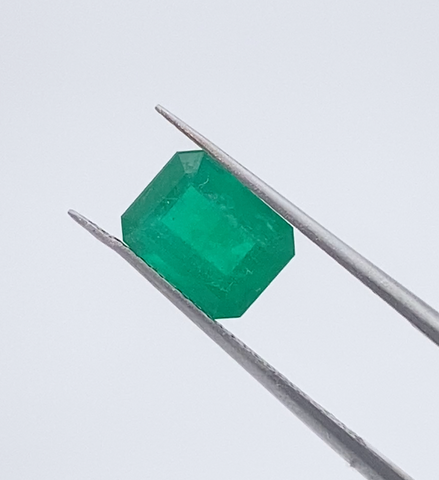Emerald Stone: Prices, Quality Comparisons, Origins, Treatments & More!
Shop our emeralds from our curated gemstone collection here
Join us as we cover all the basics you need to know before buying and emerald. We will cover how to understand the different qualities and their corresponding price points, treatments, origins, synthetics and more!
If you are interested in creating a custom engagement ring, send us an email at info@fineandflux.com or you can also view our custom jewelry gallery to see our latest pieces. 0% interest payment plans available upon request.
What is an Emerald?
Emeralds are part of the beryl family, which is a large family of stones that varies in colors. The most well-known stone within the family would be Emerald! It is a precious stone along with diamonds, rubies, and sapphires.
In the Beryl family you’ll find aquamarine, morganite, heliodor, and green beryl.

They all have the same chemical composition, colored by trace elements. Meaning, the chemicals that color them are not part of their chemical composition, they just happened to be there when the crystal was forming. For example, Emeralds are colored by Vanadium whereas aquamarine is colored by iron.
Understanding Qualities of an Emerald
Color: The color is the most important factor when buying an emerald. Like sapphires, you don't want to go too light or too dark but somewhere in the middle. Emeralds that also have a slight blue tint will be worth more.

Clarity: Emeralds are more included than any stones in the Beryl family. They are known to be more included than many other gemstones. Their inclusions are actually referred to as Jardin, a garden of inclusions. Depending on the inclusions, gemologists can determine where the Emerald originates from.
A clean emeralds really hikes up the value of a stone. For example, a clean 0.71 ct emerald goes for $1100 whereas a more included one goes for $500.
Emeralds are pretty durable in the sense that they won’t scratch, being a 7.5 on 10 of the Moh's hardness scale. However, they are prone to crack when hit with impact due to their inclusions. This is why you want to make sure if there are larger inclusions, they won't affect the integrity of the stone.
We also recommend that for engagement rings or jewelry you plan to wear everyday, to set them in bezel settings which will protect the stones.
Size: For some stones, like amethyst or garnets, the price per carat will usually stay in the same price range even as the carat weight increases. However, with emeralds, as the carat weight rises, the price per carat also rises. For example, a 1ct emerald could go for $1000 per carat, whereas a 2ct emerald could go for $5000 per carat. This happens because Emeralds in larger sizes are difficult to find.

Cut: For emerald cuts, we recommend staying away from pear cuts, marquise or any other cut with fragile points as they will render the stone more fragile. This is the exact reason we have "emerald" cut stones, the corners are purposefully cut in order to prevent fractures and increase it's durability.
What Are The Best Emerald Origins?
Like sapphires that originate from Kashmir, emeralds will also fetch premiums for high quality stones from certain mines or regions. For emeralds coming from Columbia this is most certainly the case. But do not be mistaken, it is not for all emeralds coming from Columbia that it will be worth more. The stones still need to be of good quality.
Although Columbia is known to produce beautiful Emeralds, it’s important to note that you can find that quality of Emeralds elsewhere and limiting yourself to one mine can take longer to source your stone when looking for something specific.
Emerald Prices
We published a full breakdown with real life examples of different quality emeralds with their according prices in the video above. You can skip to the first section of the video titled "emerald qualities and prices" or to the very end for "eye candy" where we show top Emerald specimens over 2cts with prices.
Treatments
Although heat treatment is common with sapphires, Emeralds are not heated as the stone is too sensitive. However, a common treatment with emeralds is oiling. It is when an emerald is vacuum sealed with ceaderwood oil, so that all the fractures within the emerald are filled with oil and therefore masking their appearance.
Any oil can be used, however, cedarwood oil is most commonly used as it has a very similar refractive index as Emeralds, meaning all the fractures become invisible. Once an emerald is oiled, it will likely never have to be re-oiled.

There are levels of oil treatment: No oil, minor oil, and heavy oil. The level of treatment does affect the price. A good quality stone will usually have minor to moderate oiling. That is totally normal and accepted in the industry. However, any treatment on stones should always be disclosed.
Sometimes colored oil will be used, however, that is not an accepted treatment. It is similar to dying your stone. Another unaccepted treatment in resin filling which is the same as oil treatment, except with resin. Resin is unaccepted because it is a permanent addition to your stone and acts as a glue.
Synthetic Emeralds
Much like other synthetic stones, synthetic emeralds are very similar to natural emeralds. Because they are created in a lab, they will usually be cleaner, and more saturated. With a microscope, a gemologist can tell the difference between a natural and synthetic emerald.
If you are looking to source an Emerald, or have any questions, please don't hesitate to reach out at info@fineandflux.com. We specialize in custom jewelry, so if you're looking for something specific, we can always help!



